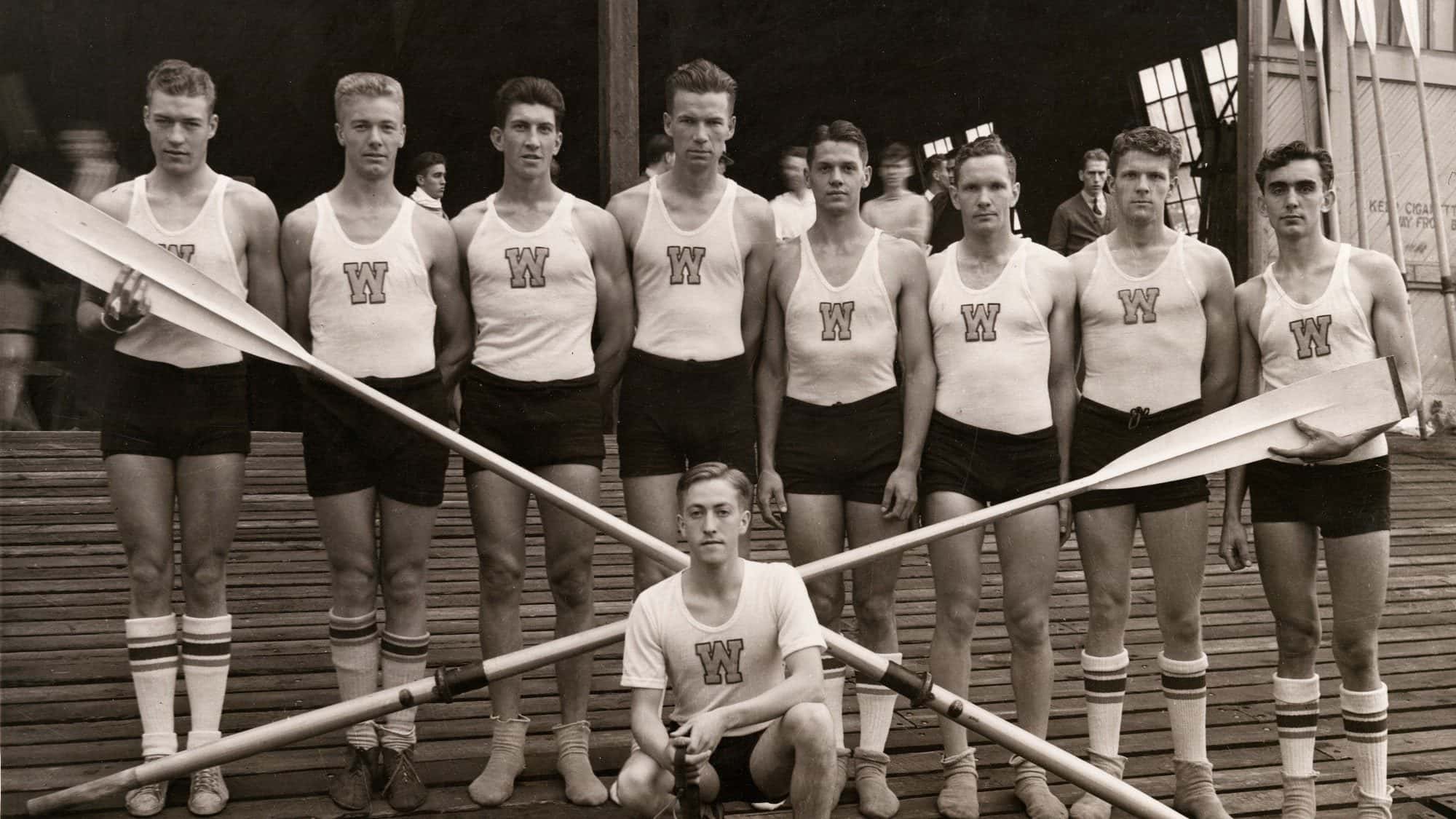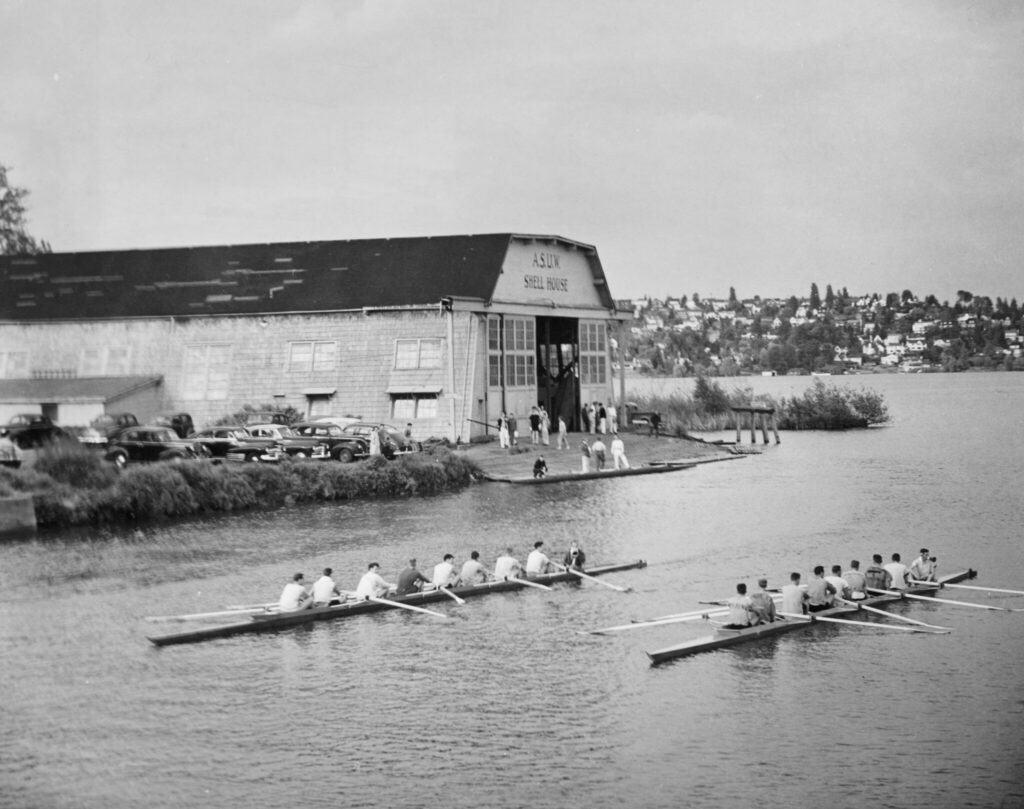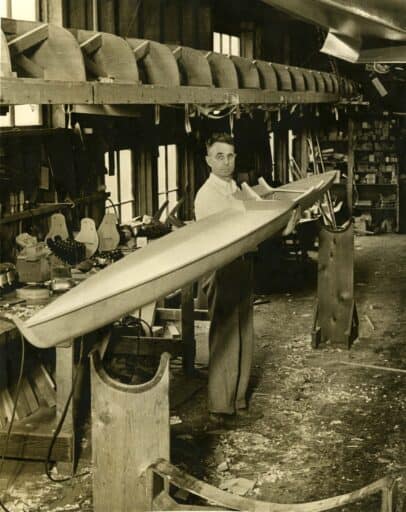Features
The Book that Saved a Building
The Boys in the Boat has become a worldwide phenomenon as the movie prepares for a Christmas Day voyage
By Heidi Mills October 24, 2023

This article originally appeared in the November/December 2023 issue of Seattle magazine.
The new issue will be released at the end of October. Subscribe here.
They journey to the old, wooden boathouse on the Montlake Cut from all corners of the country and world. As fans of the bestseller The Boys in the Boat, they want to see firsthand the more than 100-year-old structure that still sits on the Cut, long witness to a parade of rowers, paddlers, and boaters cruising by. Here, an unlikely group of Depression-era, working-class University of Washington rowers trained to capture an Olympic gold medal in the men’s eight in 1936 Nazi Germany. Thanks to the best-selling book by longtime Redmond resident Daniel James Brown, the light-filled, fir structure became a destination to thousands of curious history lovers.
This December will bring a new flood of visitors and the final boost in a long campaign to restore the historic Associated Students of the University of Washington (ASUW) Shell House. The Boys in the Boat movie, directed by George Clooney and released by MGM, will come to theaters Christmas Day. At the same time, supporters of the century-old boathouse, where “the boys in the boat” trained, have almost reached their $18.5 million goal to renovate and repurpose the historic building. They have $600,000 remaining, with a community-wide campaign this October.
They plan to turn the 12,000-square-foot Shell House, which has served as a storage facility and canoe house since rowers left in 1949, into an event space, museum, and gathering spot for students. The loft where George Pocock — who began by building boats for the UW crew in the early 20th century and who is credited with turning Seattle into a rowing hub — crafted his wooden shells will come back to life.
“This building has been saved by a book,” says Nicole Klein, capital campaign manager for the ASUW Shell House. “People walk into that boathouse and feel emotional. It’s a powerful thing.”
The Boys in the Boat film’s release will also coincide with a new exhibit on rowing history at the Museum of History and Industry. “Pulling Together: A Brief History of Rowing in Seattle” will run from Nov. 24 to June 2 and include rowing jerseys, uniforms, and medals from the Olympics, boat-building tools, and a Pocock eight hanging in the atrium. The exhibit will highlight the 1936 Boys in the Boat team but will also touch on Seattle’s broader rowing history, including the Pocock family. MOHAI partnered with The Pocock Foundation, the UW, and the Northwest Maritime Center to create the exhibit and offer lectures, films, and learn-to-row opportunities.
Listen to the interview with author Daniel James Brown in our podcast: Episode 1 Episode 2
Both the film project and shell house restoration campaign have been years in the making. Movie studios contacted Brown more than a decade ago, before The Boys in the Boat book was even published.
Brown was on vacation in Arizona with his wife and was about to head out for a tennis match when he received a phone call from his agent telling him to remain in his hotel room because publishers and movie studios were going to call. Brown took the first call, assuming he would be pitching his book. To his astonishment, he realized quite the opposite was happening, and the publisher was actually pitching him.
Though bidding for film rights happened immediately, the actual movie took years longer than Brown anticipated. The Weinstein Co. bought the rights, but the subsequent scandal and demise of the once-mighty Harvey Weinstein meant the movie was shelved for years. Eventually, Lantern Entertainment and MGM acquired the project. Delayed further by the Covid pandemic, The Boys in the Boat finally began filming in March 2022.
Though many Seattleites would have loved to see The Boys in the Boat film in its true setting, Clooney brought the film production close to his home in England. A wooden boat builder took George Pocock’s old plans and recreated the Husky Clipper, which the UW crew rowed in during its gold medal victory. A full replica of the ASUW Shell House was built on the River Thames.

The upcoming movie The Boys in the Boat led to a fundraising campaign to save the historic ASUW Shell House on the University of Washington campus.
University Of Washington Libraries, Special Collections, UW 2441, Ernest B. Bertelson
When UW rowers traveled to England to compete in the 2022 Henley Royal Regatta, they visited the set and met Clooney as well as the film’s cast. Clooney later showed Brown a photo on his phone of the rowers standing with him, laughing at how short he looked next to the extremely tall young men. The actors playing Husky rowers spent time socializing with the athletes.
“There was an equal amount of awe on both sides,” says Eric Cohen, creator of huskycrew.org and a rowing historian. “The actors were just as excited to see the team as the team was to see the actors.”
Upon completion of the film, Clooney invited Brown and his wife to a special screening at the Warner Brothers lot in Los Angeles. Brown felt nervous before the viewing, as the book had meant so much to him and he’d relinquished all control upon selling the movie rights. He walked away from the viewing feeling relieved. He’s convinced audiences will find the film inspiring and touching.
Clooney told Brown that one of his biggest challenges was filming on water and making the rowing scenes realistic. Brown is not a rower himself, and does not plan to become one. He accompanied UW rowing coaches in a launch during a bitter cold February practice while researching the book, and he thought it looked impressive but absolutely miserable. He hopes, however, that rowers will enjoy the movie as much as he did. They might nitpick detail, Brown says, but thinks they’ll appreciate the uplifting message.
“I think they will like the movie as a celebration of rowing,” Brown says.
When the film is released, the campaign to raise funds for the ASUW Shell House should be in its final stretch, if not completed. The project’s leaders plan to select an architect and contractor in November. They aim to have construction finished by June of 2026, when the FIFA World Cup comes to Seattle and brings sports fans from around the world.
The boathouse, once restored, will be a symbol of the Northwest’s connection to wood, water, boats, tribal history, and aviation history. Before the Montlake Cut connected Lake Washington and Lake Union, the Duwamish tribe portaged canoes across the narrow strip of land there.
The boathouse itself was constructed in 1918, after the completion of the Cut; the building was a Navy seaplane hangar to be used in World War I. It’s one of only two surviving wood hangars from the era. Following the war, it was converted into the ASUW Shell House. The Husky crew moved to Conibear Shellhouse in 1949, and the old Shell House became the Canoe House and a storage facility. Cohen, who was a Husky coxswain before becoming a volunteer rowing historian, marvels that the wooden structure is still standing more than 100 years after its inception.
“How did we get so lucky? How did we get that blessing?” Cohen notes. “It’s a miracle it’s still here.”
Shell House backers like to say a book saved the boathouse, and Brown himself acknowledges that The Boys in the Boat was pivotal in bringing the old structure back to life. It took the massive popularity of his book to launch the fundraising campaign. The project was boosted by several large donations, including $5 million from Microsoft President Brad Smith and his wife, NanoString Vice President Kathy Surace-Smith, and $2 million from Microsoft. More than 800 individuals have now donated to the project, many writing notes with “in honor of” or “in memory of” loved ones with connections to Husky rowing or the Shell House.
Though the exact design of the renovated Shell House has yet to be finalized, boosters envision an event space that could be rented for weddings and other gatherings. Old photographs and artifacts will pay homage to the site’s rich tribal, naval, and rowing history. Students will find space to hang out, study, and meet up. Brown’s favorite part of the plans is the restoration of George Pocock’s old shop.
“The most important thing to me is that loft in the back of the building,” Brown says. “I want Pocock’s workshop devoted to the art of building boats.”

George Pocock perfected the craft of boatbuilding and built the shells used by the 1936 Olympic champion crew team.
University Of Washington Libraries, Special Collections, UW 3557A
If the movie is successful, a new surge of visitors will likely show up at the old boathouse. The UW Rowing Stewards have been meeting for the past 18 months to talk about how to handle the visitors, what kind of screenings they can host, and what UW rowing gear they can sell. There’s no shortage of “Ws” on flags and other Husky rowing paraphernalia in the film, and Brown thinks that’s a good thing. Before he started researching The Boys in the Boat, he had no idea of the importance of rowing in Seattle’s history, and he’d like others to discover the same rich stories and core values of crew.
Brown remembers the first time he visited the ASUW Shell House. Shortly after The Boys in the Boat was published in 2013, Brown first set foot in the ASUW Shell House with a screenwriter involved in the film project and Judy Rantz Willman, the daughter of rower and main character Joe Rantz. They snuck in an open side door, and though they were shortly escorted out, Brown spent a moment taking in the old space. It felt like a cathedral, with a soaring wooden ceiling and light streaming in from walls of windows in all directions. It was just as Brown had imagined when writing his book.
“It matched my expectations,” Brown recalls. “It was beautiful.”
Though Clooney didn’t film in the old Shell House, Brown and boathouse backers would love to see him and his cast visit when the film is released. It’s a distinct possibility. Perhaps Clooney can walk out those old wooden doors, stand beside the Montlake Cut as the morning sun lights the water aglow, and imagine the Boys of ’36 rowing by in a wooden Pocock racing shell.




